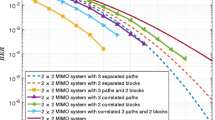Abstract
In this paper, we present the first super-quasiorthogonal space-time trellis codes (SQOSTTCs) for systems with four transmit antennas using various types of rectangular signal constellations to increase the spectral efficiency up to 5 bits/s/Hz. In our wireless communications system, we define an eight-dimensional (8D) signal constellation as Cartesian product of four two-dimensional (2D) rectangular signal sets. The transmission of an 8D point from the first antenna is achieved by transmitting four concatenated 2D points in four consecutive channel uses. The 2D symbols transmitted from the other three antennas are not independent but so chosen as to form, together with the symbols transmitted from the first antenna, the entries of a 4×4 quasiorthogonal transmission matrix. The union of two sets of quasiorthogonal transmission matrices forms a so-called super-quasiorthogonal signal set. With the 4×4 quasiorthogonal transmission matrices, we then label the state transitions of a trellis diagram describing the operation of the encoder. The simulation results of the frame error rate and the bit error rate demonstrate the excellent performance of our proposed SQOSTTCs.















Similar content being viewed by others
References
Tarokh V, Seshadri N, Calderbank AR (1998) Space-time codes for high data rate wireless communications: performance criterion and code construction. IEEE Trans Inf Theory 44:744–765
Alamouti SM (1998) A simple transmit diversity technique for wireless communications. IEEE J Sel Areas Commun 16:1451–1458
Siwamogsatham S, Fitz MP (2002) Robust space-time codes for correlated Rayleigh fading channels. IEEE Trans Signal Process 50:2408–2416
Ungerboeck G (1982) Channel coding with multilevel/phase signals. IEEE Trans Inf Theory IT-28:55–67
Ionescu DM, Mukkavilli KK, Yan Z, Lilleberg J (2001) Improved 8- and 16-state space-time codes for 4 PSK with two transmit antennas. IEEE Commun Lett 5:301–303
Siwamogsatham S, Fitz MP (2001) Improved high-rate space-time trellis codes via orthogonality and set partitioning. In: Proc. 4th Int. Symp. on Wireless Personal Multimedia Communications, WPMC’01. Aalborg, 9–12 September 2001, pp 1439–1444
Ionescu DM (2003) On space-time code design. IEEE Trans Wirel Commun 2:20–28
Jafarkhani H, Seshadri N (2003) Super-orthogonal space-time trellis codes. IEEE Trans Inf Theory 49:937–950
Divsalar D, Simon MK (1988) The design of trellis coded MPSK for fading channels: performance criteria. IEEE Trans Commun 36:1004–1012
Sterian CED, Laue F, Pätzold M (1999) Trellis-coded quadrature amplitude modulation with 2N-dimensional constellations for mobile radio channels. IEEE Trans Veh Technol 48:1475–1487
Sterian CED, Wang C-X, Johnsen R, Pätzold M (2004) Rotationally invariant space-time trellis codes with 4-D rectangular constellations for high data rate wireless communications. J Commun Netw 6:258–268
Sterian CED, Singh H, Pätzold M, Hogstad BO (2006) Super-orthogonal space-time codes with rectangular constellations and two transmit antennas for high data rate wireless communications. IEEE Trans Wirel Commun 5:1857–1865
Tarokh V, Jafarkhani H, Calderbank AR (1999) Space-time block codes from orthogonal designs. IEEE Trans Inform Theory 45:1456–1467
Tarokh V, Jafarkhani H, Calderbank AR (1999) Space-time block coding for wireless communications: performance results. IEEE J Sel Areas Commun 17:451–460
Jafarkhani H (2001) A quasi-orthogonal space-time block code. IEEE Trans Commun 49:1–4
Tirkkonen O, Boariu A, Hottinen A (2000) Minimal nonorthogonality rate 1 space-time block code for 3+Tx antennas. In: Proc. of IEEE 6th international symposium on spread spectrum techniques and applications 2000, vol 2. IEEE, Piscataway, pp 429–432
Sharma N, Papadias CB (2003) Improved quasi-orthogonal codes through constellation rotation. IEEE Trans Commun 51:332–335
Su W, Xia X (2004) Signal constellation for quasi-orthogonal space-time block codes with full diversity. IEEE Trans Inf Theory 50:2331–2347
Jafarkhani H, Hassanpour N (2005) Super-quasi-orthogonal space-time trellis codes for four transmit antennas. IEEE Trans Wirel Commun 4:215–227
Wang D, Wang, H, Xia XG (2007) Space-time trellis code design based on super quasi-orthogonal block codes with minimum decoding complexity. IEEE Trans Commun 55:1441–1447
Ferre G, Cances JP, Meghdadi V, Dumas JM (2007) STBC-based (Turbo) STTC codes built by set partitioning for three transmit antennas: construction and performances. IEEE Trans Wirel Commun 6:827–832
Shiu D-S, Foschini GJ, Gans MJ, Kahn JM (2000) Fading correlation and its effect on the capacity of multielement antenna systems. IEEE Trans Commun 48:502–513
Abdi A, Kaveh M (2002) A space-time correlation model for multielement antenna systems in mobile fading channels. IEEE J Sel Areas Commun 20:550–560
Pätzold M, Hogstad BO (2004) A space-time channel simulator for MIMO channels based on the geometrical one-ring scattering model. Wirel Commun Mob Comput 4:727–737 (special issue on multiple-input multiple-output (MIMO) communications)
Pätzold M (2002) Mobile fading channels. Wiley, Chichester
Abdi A, Barger JA, Kaveh M (2002) A parametric model for the distribution of the angle of arrival and the associated correlation function and power spectrum at the mobile station. IEEE Trans Veh Technol 51:425–434
Sterian CED (1997) Exact formulas for computing the energy of “square” and “cross” two-dimensional rectangular signal constellations. Eur Trans Telecommun 8:547–549
Wang C-X, Pätzold M, (2003) Methods of generating multiple uncorrelated Rayleigh fading processes. In: Proc. 57th IEEE semiannual veh. technol. conf., VTC 2003-Spring, Jeju, 22–25 April 2003, pp 510–514
Acknowledgements
The authors are grateful to the anonymous reviewers for their positive criticism and for their valuable comments, which greatly helped to improve the paper and to make it more readable.
Author information
Authors and Affiliations
Corresponding author
Rights and permissions
About this article
Cite this article
Sterian, C.E.D., Wu, Y. & Pätzold, M. Super-quasiorthogonal space-time trellis codes for four transmit antennas with rectangular signal constellations. Ann. Telecommun. 63, 331–350 (2008). https://doi.org/10.1007/s12243-008-0031-8
Received:
Accepted:
Published:
Issue Date:
DOI: https://doi.org/10.1007/s12243-008-0031-8




